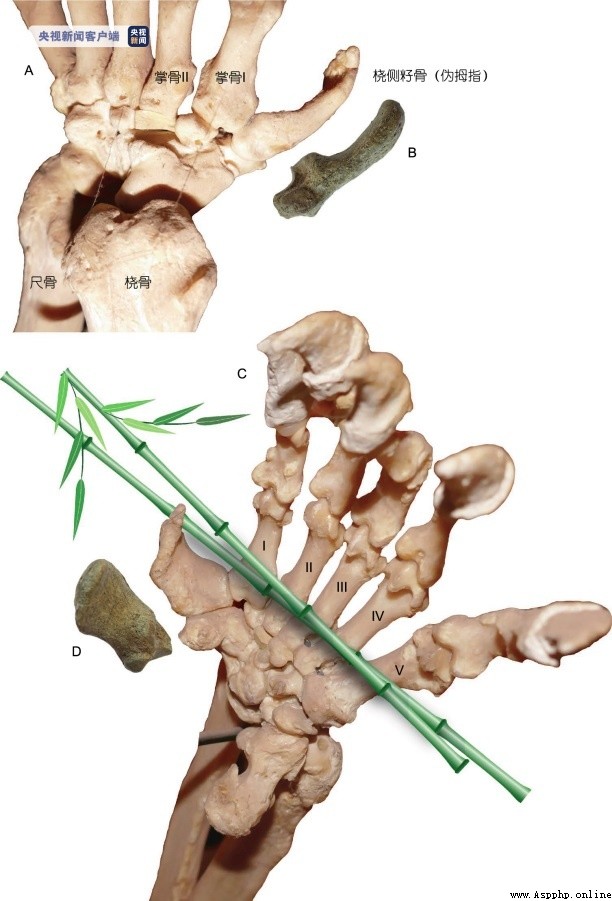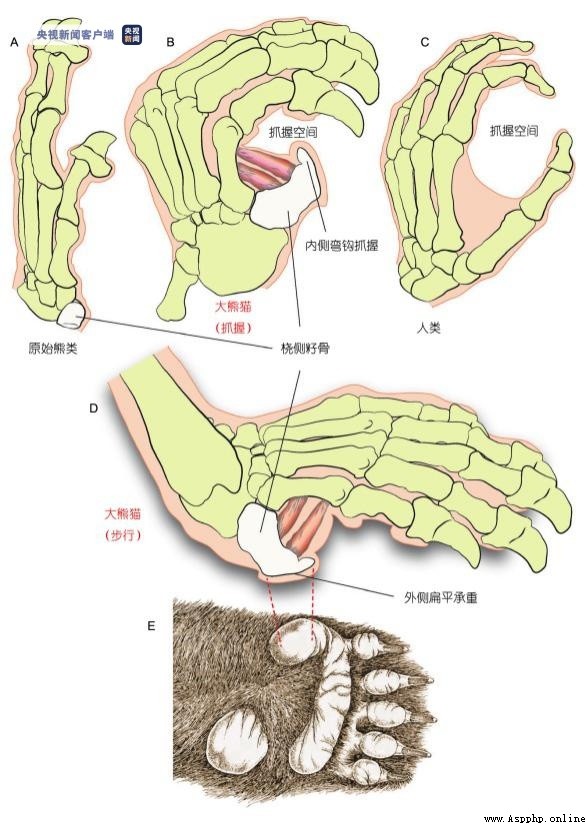Giant pandas belonging to carnivorous order are different from their brothers , It has many “ stunt ”, So that it can adapt to the life of eating bamboo . Among these stunts , Panda extra “ thumb ” It can be said to be the most famous but also the most mysterious . Except for the five normal fingers on most mammalian forelimbs , Giant pandas also have a strongly enlarged wrist bone , Radial sesamoid , Act as the sixth finger , Form something that you can grip “ thumb ” To catch the bamboo .
In recent days, , The scientific research team of the Institute of Vertebrate Paleontology and Paleoanthropology of the Chinese Academy of Sciences cooperates with its peers , In international publications 《 Scientific report 》 Published the sixth finger of the first panda , namely “ Fake thumb ” Papers on evolution . The key pseudo thumb and molar fossils of the first panda , come from 2015 Nian dengtao 、 The ancient spine Institute led by Ji Xueping 、 The scientific excavation of shuitangba late Miocene site jointly organized by Yunnan Provincial Institute of Archaeology and Zhaotong municipal government . The results show that , The first panda has the earliest enlarged radial sesamoid , Has formed a grip “ thumb ” function . However , Since the late Miocene , Panda's “ thumb ” No further increase , Because while grasping bamboo, it must also take into account the load-bearing function of plantar walking , Neither side should be neglected . The limitation of sharing weight may be the main reason why the false thumb of a panda never evolved into a complete finger , But this kind of simple “ thumb ” indicate , Giant pandas have been eating bamboo for at least a long time 700—600 It originated ten thousand years ago .

△ At the beginning of the ecological restoration of the giant panda in shuitangba, Zhaotong, Yunnan Province, the right individual shows the pseudo thumb grasping function , The left individual shows the walking posture
Although giant pandas are famous for their fake thumbs , But it is only a rather simple small and flat structure , Once puzzled early anatomists . We should find out the context of the fake thumb , Fossils are the most important evidence , But the previous earliest record was only found in Shuanghe cave, Guizhou Province, about 10.2~4.9 In the late Pleistocene sediments 10000 years ago . If grasping bamboo is the main function of this feature , Because mammalian sesamoids are easy to elongate during development , Then why didn't giant pandas evolve a more slender radial sesamoid , A sesamoid bone that is more like a real opposable thumb , In order to grasp bamboo more effectively ? This question has not been answered before , Because in the early Pleistocene, pandas - There is a lack of relevant fossil evidence in the pedigree of giant pandas . This achievement released a new discovery of the late Miocene shuitangba site in Zhaotong Basin, Yunnan , According to the earliest known enlarged radial sesamoid bone of the primordial panda , Its pseudo thumb shows an intermediate shape , It is the first time to record the possible time and steps of the evolution of panda feeding on bamboo . Among carnivores , Bears have the most complex molars , Because they also chew a lot of non meat food . And among bears , Pandas have the most delicate tooth patterns , Fold out many very obvious tooth tips , With the help of strong mandible and temporomandibular joint , It is conducive to chewing hard bamboo . The tooth morphology of the first panda has reached the complexity of modern giant pandas , Even more complicated . Has shipanda started eating bamboo ? The false thumb that can help grasp the bamboo pole is another key evidence .

△ panda (A, C) Heshi panda (B, D) Anatomical structure of pseudo thumb
The grasp of giant pandas is fundamentally different from that of humans , The radial sesamoid bone forms a functional complex with the first metacarpal bone and scaphoid lunate bone by fixing the joint , Linkage with other metacarpal bones , It cannot move independently of other fingers like the human thumb . This passive grasping system is far less effective than human active grasping system , But it is enough to provide giant pandas with the grasping ability they need to eat bamboo . Besides , From an evolutionary point of view , Even though the radial sesamoid bone initially only slightly enlarged , It can also form a simple but useful grip function , Moderately prevent bamboo from slipping from fingers .

△ panda (B, D, E) And primitive bears (A) And humans (C) Hand comparison
Longer fingers will definitely enhance the ability to grasp the bamboo pole , Then why didn't the panda's fake thumb lengthen further ? Research suggests , The radial sesamoid bone did not extend further , It is the functional harmony between grasping the bamboo pole and bearing weight with the pseudo thumb . Canidae 、 Cats and hyenas and other running carnivores have different toe lines , Fat bears are all metatarsal , Before walking 、 The back foot touches the ground . The strongly elongated radial sesamoid bone is more conducive to grasping bamboo , But it inevitably conflicts with long-distance walking , Thus damaging the dual function of the pseudo thumb —— The inner surface is used for grasping and the outer surface is used for bearing . Any further enlargement of the radial sesamoid bone will cause it to protrude more significantly out of the palmar surface , So as to interfere with walking , In layman's terms , It will hurt your feet . therefore , Living giant pandas balance the conflict between functions by sharply bending the end of the pseudo thumb inward into a hook shape . Among the existing bears , Only giant pandas have a large meat pad to cushion the radial sesamoid , It shows that the load-bearing function of this bone is very important .

△ Giant pandas grasp and chew bamboo
Pandas have transitioned from a wide range of omnivores to eating bamboo wholeheartedly , Logically speaking, it needs to be in anatomy 、 Multiple changes based on physiology and genetics . However , Even after at least 600 10000 years of history focusing on eating bamboo , These changes are still limited , Mainly focused on feeding skills , The digestive system of giant pandas is still the configuration of carnivores . After the late Miocene , The fact that the false thumb of the panda family does not extend further shows , They have gained enough grip to deal with bamboo . in other words , Enough to grasp a bamboo pole or a handful of bamboo , At the same time, I have to support my fat body to walk , Pseudo thumb is not long or short, just right .